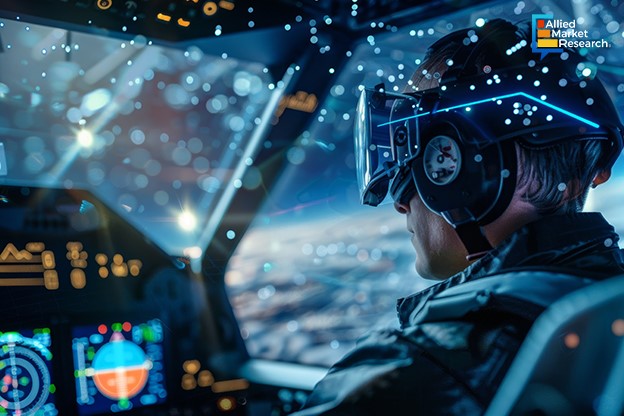Aviation Augmented & Virtual Reality: Enhancing Flight Experience with Simulation

27 Nov
2024
Key takeaways
- Introduction
- AR/VR based learning tools
- Maintaining aviation safety with AR and VR
- Future of aviation augmented and virtual reality
- Strategic initiatives by leading players
Aerospace and aviation are two advanced sectors that integrate intricate design structures and mechanisms. AR and VR are two prime technologies that are rapidly evolving and have the potential to revolutionize multiple industries. From airspace information, terrain, weather, and air traffic control to visualizing navigation systems, these technologies have streamlined various operations in aviation management.
AR is an augmented version of the real world, while VR offers a fully immersive, simulated digital environment, by utilizing similar technologies. These technologies have widespread applications across training, design, development, and maintenance. A report published by Allied Market Research states that the aviation augmented and virtual reality market is predicted to witness impressive growth throughout the forecast timeframe. This is due to the increase in the manufacturing and delivery of commercial aircraft.
AR/VR-based tools to improve the learning experience
Aerospace solutions engineers face challenges in accessing effective learning materials, as they work with complex and costly structures that cannot be utilized for training purposes. Virtual reality offers a faster, more effective learning solution by providing a simulated environment that allows engineers to view, explore, and experiment with virtual aircraft structures. This technology allows them to study parts, understand flaws, and showcase a simulated aircraft environment for a hands-on learning experience.
Currently, most airlines have collaborated with other different AR and VR companies to train their employees. VR simulations enable the crew to enhance their knowledge, skills, and adaptability. Aviation professionals can adapt themselves to different situations with practical training in a virtual atmosphere without using an actual aircraft.
Role of AR and VR in maintaining aviation safety
Aviation is considered the safest mode of travel, but safety remains a top priority. Proper training reduces the chances of errors and helps detect issues early, minimizing risks to passengers' lives. VR offers a safe, controlled environment for staff training, allowing them to practice handling various situations and conditions without real-world consequences, ultimately helping prevent fatal accidents during flights.
AR and VR enable the visualization and interaction with complex aircraft mechanisms during the design phase. They enable personnel to simulate, analyze, and refine designs while making necessary adjustments before implementing them into the real world.
Futuristic AR and VR transforming aerospace operations
AR and VR technologies have great potential in the aviation industry. AR/VR virtualization and digital twins give airlines real-time data, which coupled with predictive tools, helps enhance decision making. The integration of AR and VR in the airline industry is anticipated to lead to a dynamic shift in power distribution.
Virtual reality headsets have the potential to be a future application of augmented reality in air travel. These headsets offer passengers an immersive experience during their flight and enable them to explore destinations or enjoy interactive entertainment. On the other hand, augmented reality in air travel is predicted to involve holographic displays in the future. For instance, passengers can receive information and instructions in real time through holographic projections.
Collaborative efforts delivering advanced offerings
Top entities in the aviation industry are investing in AR and VR technology to enhance their aerospace operations and customer experience. They are collaborating to introduce advanced products with dynamic features. For instance, GridRaster and Jeh Aerospace partnered in August 2024 to integrate XR and AI technologies into aerospace manufacturing. This collaboration aims to advance Spatial AI, VR, and AR abilities for inspecting, training, and handling custom cases in aerospace production. Jeh Aerospace plans to utilize GridRaster's Spatial AI and Dynamic XR platform to enhance various aspects of its aerospace module manufacturing processes.
Similarly, Vection Technologies partnered with ALTEC, Next One Film Group, and Thales Alenia Space, in August 2023, to create a VR metaverse platform, Lunar City, designed for space exploration. This platform aims to motivate future astronauts and inspire space travel, aligning with NASA's Artemis Program, which works to return astronauts to the Moon.
End note
To conclude, AR and VR technologies are estimated to revolutionize the aviation industry by enhancing training, improving safety, and optimizing operations. With advancements in virtual simulations and real-time data visualization, these innovations are expected to build a future of safer, more efficient, and immersive air travel experiences for professionals and passengers.
Contact us to gain deeper insights into the aviation augmented and virtual reality market

Koyel Ghosh
Author’s Bio- Koyel Ghosh is a blogger with a strong passion and enjoys writing in miscellaneous domains, as she believes it lets her explore a wide variety of niches. She has an innate interest in creativity and enjoys experimenting with different writing styles. A writer who never stops imagining, she has been serving the corporate industry for the last five years.
Avenue: Entire Library membership of Allied Market Research Reports at your disposal
- Avenue is an innovative subscription-based online report database.
- Avail an online access to the entire library of syndicated reports on more than 2,000 niche industries and company profiles on more than 12,000 firms across 11 domains.
- A cost-effective model tailored for entrepreneurs, investors, and students & researchers at universities.
- Request customizations, suggest new reports, and avail analyst support as per your requirements.
- Get an access to the library of reports at any time from any device and anywhere.
Related Post
-
How are Submarine Cables Transforming Global Connectivity with Enhanced User Experience?
-
Endoscopy Procedures: Transformations in Techniques and Applications
-
AI-Powered Video Analytics: How the Product Actually Works for enterprises
-
Painting Robots: Transforming Precision Coating and Creative Applications
-
Innovations in Pharmacovigilance Systems Advancing Patient Safety
-
Understanding Edge Security: Keeping Data Safe Near the Source
-
Exploring the Use and Advancements of 3D Laser Scanners in Professional Applications
-
Reinforcing Industrial Controls with Smarter Tools and Training








